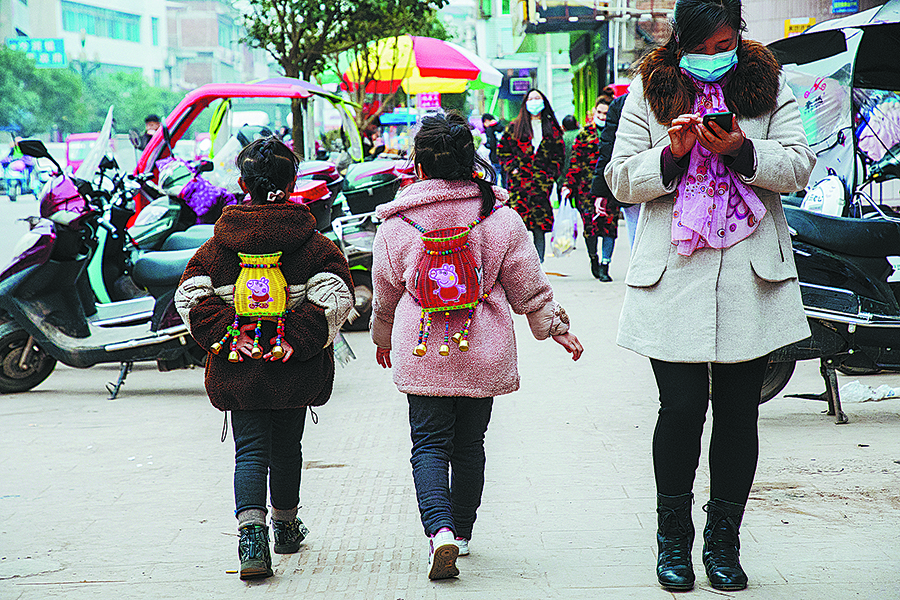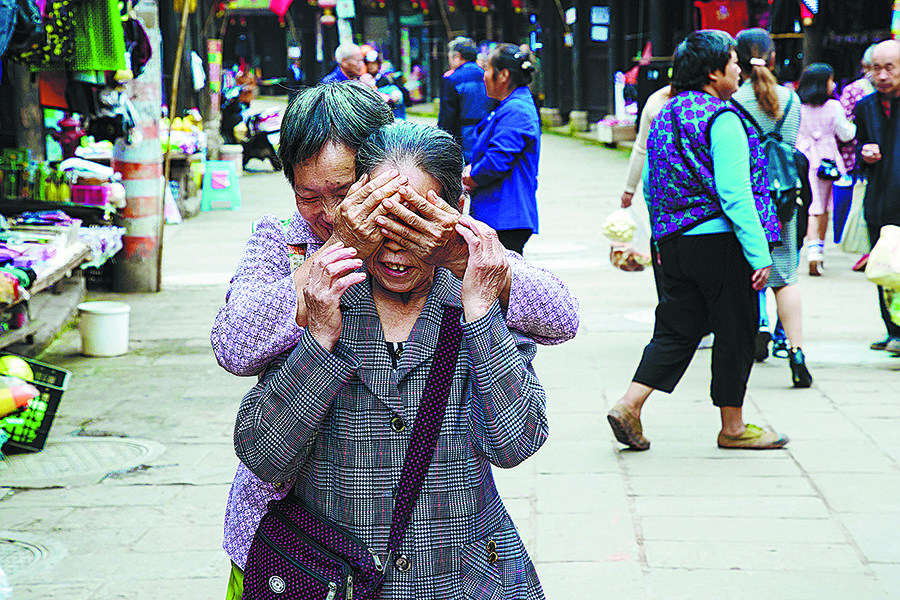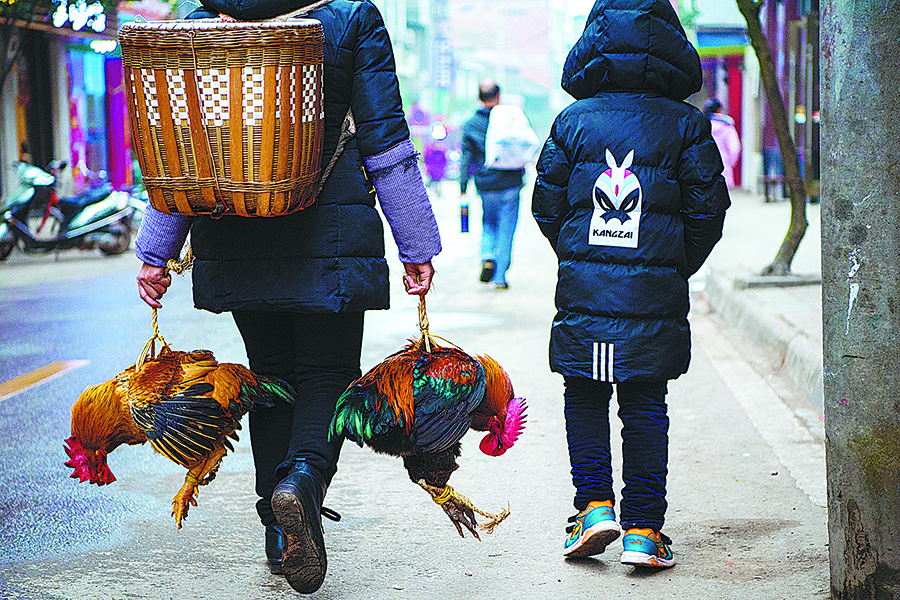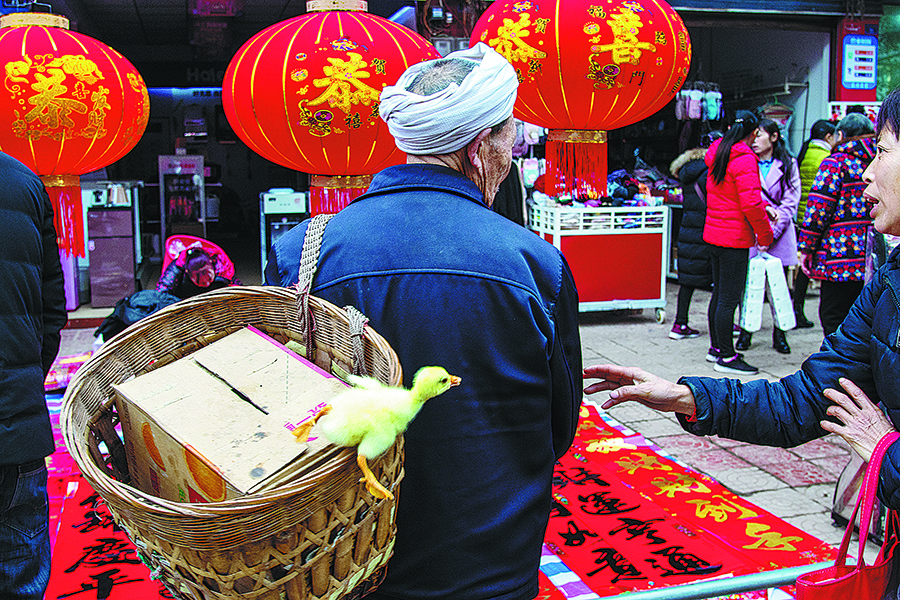
Two girls are happy with their newly bought "Peppa Pig" bags at a market in Shahe town, Gaoxian county, Yibin city, Sichuan province, Jan, 2021. [Photo by WANG DAGANG/CHINA DAILY]
The town fair, a scene comfortably familiar to me, is a major hub for bargains. It was the most important commodity collecting and distributing center for those, like me, growing up in the countryside.
One does not have to escape to the wilderness to seek inspiration, and creativity can produce the beautiful from everyday life.
Over the years, I have been using my camera to capture moments of life in town markets in southern Sichuan province. It is a permanent record of life kept on film as I was actually living it
In 13 years of filming, more than 600 occasions I rushed to the scene, covering 138 towns in 38 counties in five prefecture-level cities in southern Sichuan (Yibin, Luzhou, Zigong, Neijiang and Leshan). Markets in different places have their own uniqueness: the market in Xijie town, Xuzhou district, Yibin city, is right next to the Minjiang River. Every day when the market opens, villagers on the opposite bank cross the river by boat and come to the town's riverside to buy and sell. A little market certainly but, nevertheless, it has everything to offer-food, beverage and clothing.

Two women in the market greet each other full of playfulness in Hengjiang town, Xuzhou district, Yibin city, Oct 19, 2019. [Photo by WANG DAGANG/CHINA DAILY]
The market in Shengtian town, Gaoxian county, is set into a hillside, and the streets of the market are laid out in the shape of a well. No matter how small the town is, there are clothing stores, snack shops, department stores, merchandise stores, hardware stores, hairdressers, hotels, tea houses and clinics. Throughout the region there are many teahouses. Qianwei county's Luocheng town resembles a long boat from above. On both sides of the "boat street" are rows of old tiled houses with wooden structures. The locals drink tea, clear their earwax, smoke leaf cigarettes, sell sticking plasters, whatever the weather. They enjoy the blessings of earthly pleasures.
In southern Sichuan, it is indispensable to deal with locals. The people here are somewhat different from the familiar term that labels Sichuanese as "hot-tempered", "hot pot lovers" and "pleasure seeking". The market by the river boasts convenient transportation, and it is natural that people here are accustomed to the outside world, and they like to open to a mind acquainted with the world.
Known for being extremely straightforward, they also speak fast, do things quickly, neatly and simply, and don't ever drag on. The people here who have lived in the mountains for a long time are a bit shy compared with those living by the river. I wouldn't say they are modest, but they are much more sincere and honest with others. By all means they are tough and can endure hardship.

Villagers return home with full loads of special purchases for the Spring Festival in Nixi town, Xuzhou district, Yibin city, Feb 9, 2018. [Photo by WANG DAGANG/CHINA DAILY]
"Soaking" in the market, I not only used my camera to record the familiar but interesting tidbits, but also witnessed the changes in the daily life of the fellow villagers. For example, greater transport convenience is achieved as a result of the local government's constant drive in enriching the villagers' wellbeing.
The road network in rural areas and townships has developed rapidly. The villagers basically travel by car or motorcycle. However, it's widely noted that a lot of traditional customs are disappearing along with the development. For example, traditional craftsmanship such as repairing pans, shoes and clocks, sharpening knives and scissors that were common in the market in the past are now a rare scene.
Significant changes are most prominent in food and clothing choices. In the past, most of the villagers went to the market to buy salt, oil, meat and grain, and to buy traditional sweets and cakes for holidays.

The newly bought duckling in the old man's basket attempts an escape at a market in Shengtian town, Jan 21, 2020. [Photo by WANG DAGANG/CHINA DAILY]
Nowadays the market is rich and diverse in food options-cake shops, bakeries, fried chicken, burgers, french fries, milk tea, desserts, spaghetti and even barbecues and other popular foods in cities. In the past, villagers usually wore, largely, the staple blue, green and white colors. Red and yellow were rarely seen in the market.
With the improvement of living standards, clothing styles and colors that are popular in cities have also become popular in the market. The villagers live a rich life, and they are catching up with the latest fashion trends. There are mature women wearing cheongsam, earrings and bracelets, carrying large baskets of vegetables.
The rural market is a microcosm of social progress, people's livelihood and emotions.

Barefoot doctors resort to folk remedies to treat back pain for fellow villagers. These doctors are health providers who have undergone basic medical training and work mostly in rural villages. The scene attracts a crowd at the market in Shengtian town, Gaoxian county, Yibin city, June 17, 2017. [Photo by WANG DAGANG/CHINA DAILY]

A barefoot doctor gives a fellow villager a massage in Lizhuang town, Feb 22, 2019. [Photo by WANG DAGANG/CHINA DAILY]

Villagers are generally reluctant to go to the hospital if they have minor illnesses; in Lizhuang town, a man promotes winter underwear despite the cold, Jan 12, 2020. [Photo by WANG DAGANG/CHINA DAILY]

